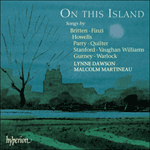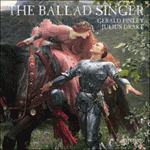Stanford’s
La belle dame sans merci is a setting of Keats’ famous 1819 ballad of the unnamed knight fatally bewitched by the mysterious ‘faery’s child’—a favourite subject for composers and pre-Raphaelite painters alike. Stanford composed this celebrated song early in 1877 (making it an exact contemporary of Sullivan’s
The Lost Chord), drawing on sketches he had made over a decade earlier. As in many of Loewe’s ballads (Stanford’s probable model), the successive verses vary the plain, bardic melody, with the piano-as-orchestra adding atmosphere and illustrative detail. A seductive, remote modulation lures the knight to his ruin (‘She took me to her elfin grot’). In the penultimate verse he awakens to eerie chromatic harmonies, before text and music return to the chill reality of the opening.
from notes by Richard Wigmore © 2011
En 1877 (en même temps, donc, que Sullivan avec
The Lost Chord), Stanford s’appuya sur des ébauches vieilles de dix ans pour rédiger sa fameuse
La belle dame sans merci, d’après la non moins célèbre ballade de Keats (1819) sur un chevalier anonyme mortellement ensorcelé par la mystérieuse enfant de fée—un thème cher aux compositeurs comme aux peintres préraphaélites. Comme dans maintes ballades de Loewe (probable modèle de Stanford), les strophes successives modifient la mélodie simple, pareille à celles des bardes, le piano-orchestre apportant atmosphère et détails illustratifs. Une séduisante modulation éloignée attire le chevalier pour le mener à sa perte («Elle m’entraîna dans sa grotte d’elfe»). À l’avant-dernière strophe, il s’éveille sur de sinistres harmonies chromatiques avant que texte et musique ne retrouvent la réalité glaciale du début.
extrait des notes rédigées par Richard Wigmore © 2011
Français: Hypérion
Stanfords
La belle dame sans merci ist eine Vertonung der berühmten Ballade von Keats aus dem Jahr 1819, in der ein unbenannter Ritter einer fatalen Verzauberung durch das mysteriöse „Feenkind“ erliegt—ein beliebter Stoff sowohl unter Komponisten als auch unter den präraffaelitischen Malern. Stanford komponierte dieses berühmte Lied 1877 (also genau zur selben Zeit wie
The Lost Chord von Sullivan) und griff auf Skizzen zurück, die er mehr als zehn Jahre zuvor gemacht hatte. Wie es auch bei vielen Balladen von Loewe (der wahrscheinlich Stanfords Vorbild war) der Fall ist, wird in den Strophen die schlichte, bardische Melodie variiert und das Klavier, das als Orchester-Ersatz auftritt, sorgt für Atmosphäre und liefert anschauliche Details. Eine verführerische, weit wegführende Modulation lockt den Ritter ins Verderben („She took me to her elfin grot“—„Sie führte mich in ihre Elfengrotte“). In der vorletzten Strophe erwacht er zu unheimlichen chromatischen Harmonien, bevor der Text und die Musik zu der kalten Realität des Beginns zurückkehren.
aus dem Begleittext von Richard Wigmore © 2011
Deutsch: Viola Scheffel


 On this Island
On this Island The Ballad Singer
The Ballad Singer
